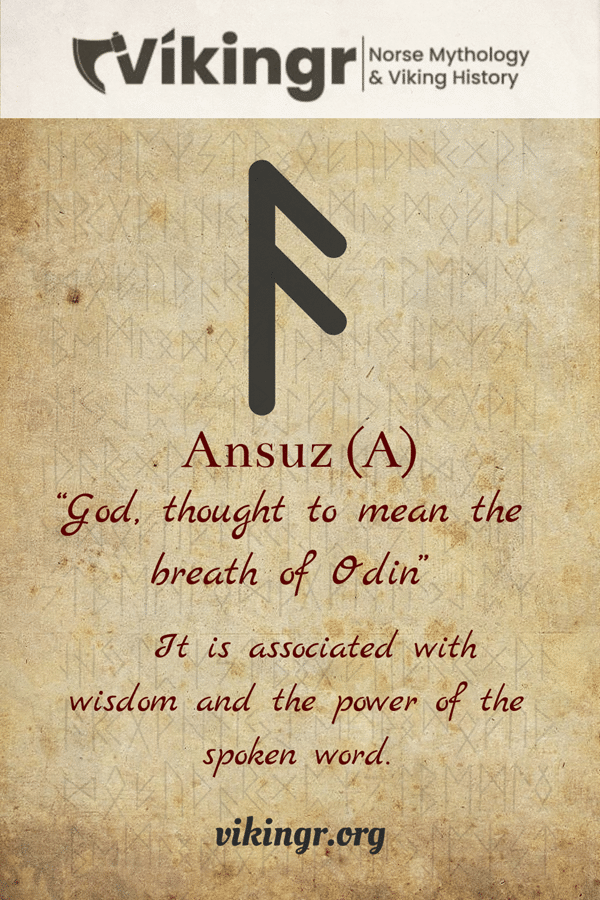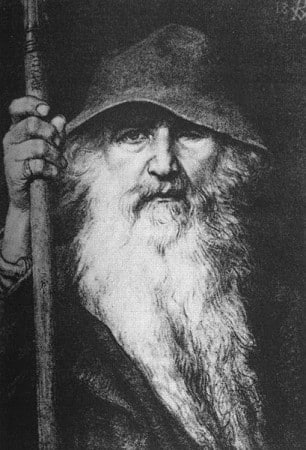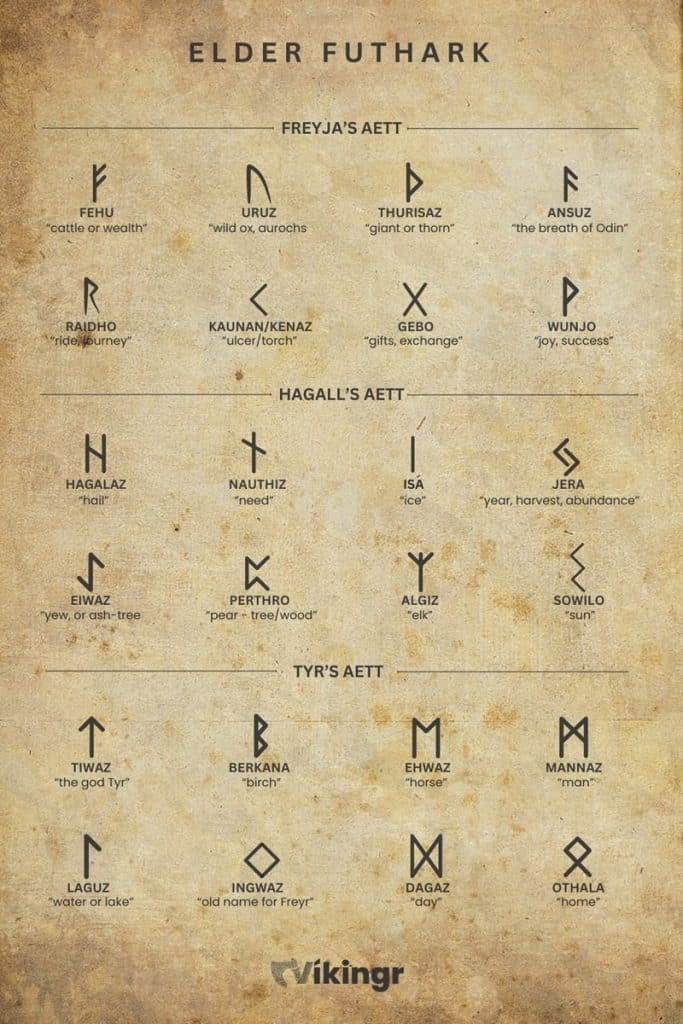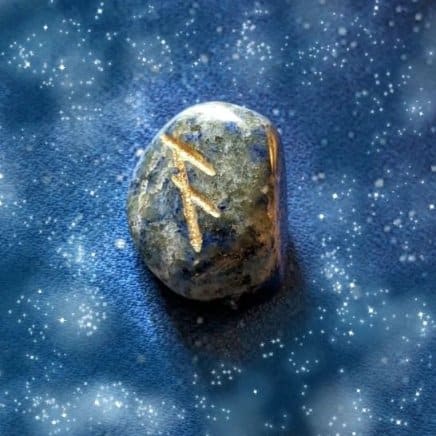In this post, I’ll be looking at the Ansuz rune, from the first aett of the Elder Futhark. The likely meaning of the Ansuz rune is associated with god, possibly Odin himself.
Historical Background
The Elder Futhark, the oldest form of the runic alphabet was developed sometime before the 4th century. This runic alphabet was used extensively by Germanic tribes like the Vikings. Ansuz is the fourth rune in the first aett. It graces artifacts and runestones scattered across Northern Europe, from Sweden and Norway to England, demonstrating its significance.
As part of the Elder Futhark, the this rune is listed on the Swedish Kylver Stone, dating back to around 400 AD. This runestone has the whole Elder Futhark alphabet listed on it and is the earliest find of its kind.

Graphical Representation of Ansuz rune
The Ansuz rune captivates visually, resembling an “F” where the “arms” are slightly drooping down. Throughout history, its basic design has remained consistent, with minor variations appearing in different regions or periods.
Phonetic Value
In the Proto-Germanic language, the phonetic value of the Ansuz rune is “a”, akin to the “a” sound in “cat”. To my understanding, this sound was present throughout the evolution of the Germanic languages.
Symbolic Meaning of the Ansuz Rune
The Proto-Germanic translation of Ansuz is “god” or “mouth”, hinting at its divine associations. In the world of the Vikings, the runes had a much deeper meaning than merely as letters. Ansuz’ symbolism is connected to the all-knowing Wise Odin, who embodies wisdom, poetry, and magic.

The rune is also linked to human expression and the power of the spoken word. This association intertwines the rune with the fabric of ancient Germanic society, emphasizing the importance of oral tradition and wisdom dissemination.
Moreover, Ansuz symbolizes divine inspiration, tying it to the breath of life or the divine wind. This concept reflects the spiritual belief system of the ancient Germanic tribes, portraying their perception of the divine realm’s influence on human life.
The Aett and its Symbolism
The Ansuz rune belongs to the first aett (aettir) of the Elder Futhark, commonly associated with the god Freyr, the Fertile. This grouping of eight runes is often seen as representing the physical world and its natural processes, including fertility, growth, and material wealth.
Within this aett, Ansuz’s association with divine communication and inspiration plays a crucial role. It signifies the divine influence on the material world, reminding us of the interconnectedness of all things and the omnipresence of the divine.
Freyr, the god associated with this aett, is a deity of prosperity, pleasure, and peace. As a figure of fertility, Freyr also represents the life-giving aspect of nature. Within this context, I found that Ansuz conveys the message of divine inspiration breathing life into the physical world, thus linking it to Freyr’s domain of influence.

Elder Futhark Quiz
Do you want to test your knowledge of Elder Futhark runes? Then this quiz is perfect for you!
Don’t forget to play our other games as well!
Ansuz Used in Divination and Magic
While I don’t personally subscribe to beliefs in divination or seidr magic, I find the use of the Ansuz rune in these contexts to be absolutely fascinating. In runic divination, Ansuz is often interpreted as a sign of divine guidance or communication from a higher power. It advises the seeker to listen to their intuition and trust the wisdom that flows from within.
Historians suggest that people used Ansuz throughout history in magical workings or spellcraft to enhance communication, wisdom, and understanding. However, concrete evidence of such practices is sparse, and much of my understanding is based on conjecture and interpretation of ancient texts.
The rune’s connection to Odin, the god of magic and wisdom, further fuels the belief in its magical properties. Many believe that people used Ansuz in rituals or spells to seek Odin’s guidance or favor.
in Inscriptions and Literature

Ansuz’s presence in ancient inscriptions and literature paints a vivid picture of its historical significance. For instance, it frequently appears in runic inscriptions on artifacts like the aforementioned Kylver Stone.
The rune also manifests in Old Norse literature, playing a symbolic role in various sagas and poems. In the Poetic Edda, a collection of Old Norse poems, Ansuz is often linked to Odin, further emphasizing its divine connections.
Moreover, in Old English texts, the corresponding rune “Os” carries similar connotations, symbolizing divine communication and the power of the spoken word. This convergence across languages underscores the wide-reaching influence and lasting legacy of the this rune.
Ansuz in the Younger Futhark – The Transformation of Divine Breath
In the transition period from the Elder Futhark to the Younger Futhark (Norse runes), around the 7th and 8th centuries, Ansuz underwent a transformation. Initially representing the ‘a’ sound, its appearance changed in the Norse runes, coming to represent the Old Norse ‘ą’ sound. This shift reflects the dynamic nature of language and communication. In the Younger Futhark, it is referred to as áss.
Frequently Asked Questions
Ansuz symbolizes divine communication, wisdom, and inspiration. It is closely associated with the Norse god Odin.
When using Ansuz in runic divination, interpreters see it as a sign of divine guidance or communication from a higher power, advising the seeker to trust their intuition.
In the Elder Futhark sequence, Ansuz appears as the fourth rune of the first aett.
Featured Image Credit: BK, Public domain, via Wikimedia Commons
